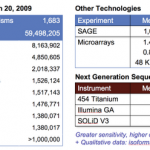BioHDF
I had the good fortune on Thursday to hear a fascinating talk on deep transcriptome analysis by Chris Mason, Assistant Professor, at the Institute for Computational Biomedicine at
Cornell University.
Several intriguing observations were presented during the talk. I'll present the key points first and then discuss the data.
These data concern the human transcriptome, and at least some of the results are supported by follow on studies with data from the pigmy tailed macaque.
Some of the most interesting points from Mason's talk were:
A large fraction of the existing genome…
These days, DNA sequencing happens in one of three ways.
In the early days of DNA sequencing (like the 80's), labs prepared their own samples, sequenced those samples, and analyzed their results. Some labs still do this.
Then, in the 90's, genome centers came along. Genome centers are like giant factories that manufacture sequence data. They have buildings, dedicated staff, and professional bioinformaticians who write programs and work with other factory members to get the data entered, analyzed, and shipped out to the databases. (You can learn more about this and go on a virtual tour in this…
I often get questions about bioinformatics, bioinformatics jobs and career paths. Most of the questions reflect a general sense of confusion between creating bioinformatics resources and using them. Bioinformatics is unique in this sense. No one confuses writing a package like Photoshop with being a photographer, yet for some odd reason, people seem to expect this of biologists. In the same respect, even the programmers and database administrators who work in bioinformatics, are unfairly assumed to have had graduate level training in biology.
In many ways, it's easiest to understand…
